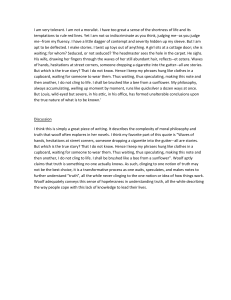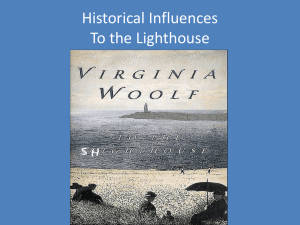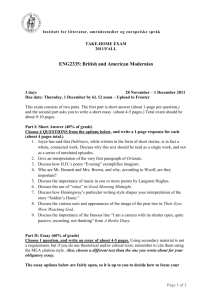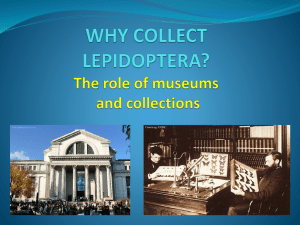Virginia Woolf`s “The Moth” The Cathartic Tone and Entrancing Style
advertisement
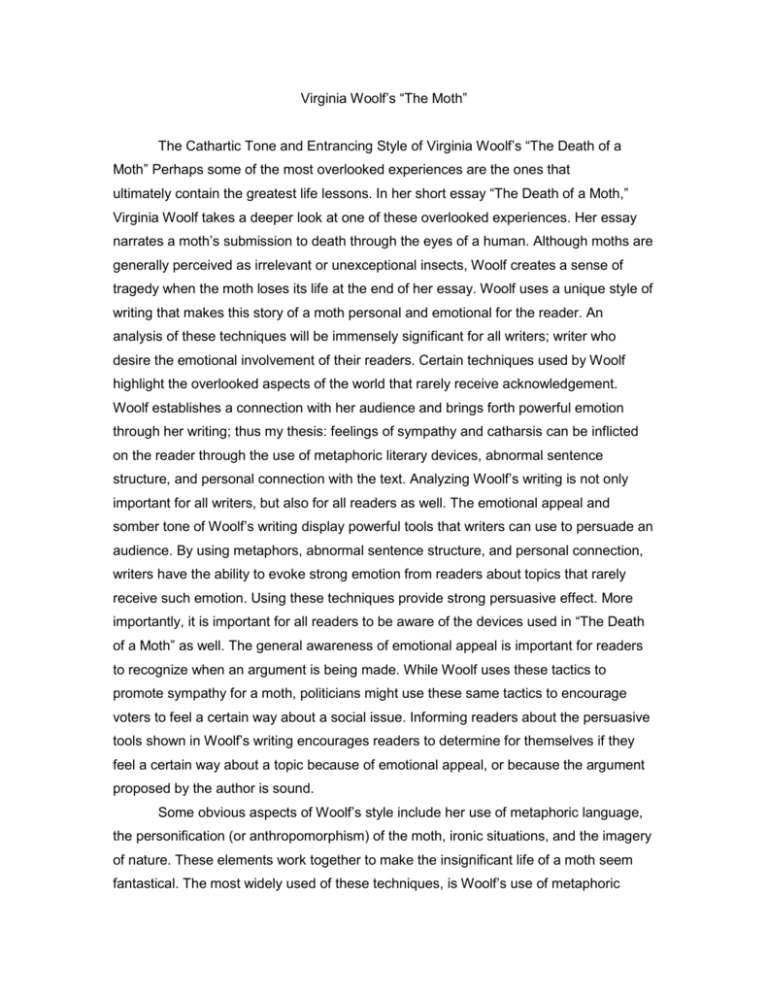
Virginia Woolf’s “The Moth” The Cathartic Tone and Entrancing Style of Virginia Woolf’s “The Death of a Moth” Perhaps some of the most overlooked experiences are the ones that ultimately contain the greatest life lessons. In her short essay “The Death of a Moth,” Virginia Woolf takes a deeper look at one of these overlooked experiences. Her essay narrates a moth’s submission to death through the eyes of a human. Although moths are generally perceived as irrelevant or unexceptional insects, Woolf creates a sense of tragedy when the moth loses its life at the end of her essay. Woolf uses a unique style of writing that makes this story of a moth personal and emotional for the reader. An analysis of these techniques will be immensely significant for all writers; writer who desire the emotional involvement of their readers. Certain techniques used by Woolf highlight the overlooked aspects of the world that rarely receive acknowledgement. Woolf establishes a connection with her audience and brings forth powerful emotion through her writing; thus my thesis: feelings of sympathy and catharsis can be inflicted on the reader through the use of metaphoric literary devices, abnormal sentence structure, and personal connection with the text. Analyzing Woolf’s writing is not only important for all writers, but also for all readers as well. The emotional appeal and somber tone of Woolf’s writing display powerful tools that writers can use to persuade an audience. By using metaphors, abnormal sentence structure, and personal connection, writers have the ability to evoke strong emotion from readers about topics that rarely receive such emotion. Using these techniques provide strong persuasive effect. More importantly, it is important for all readers to be aware of the devices used in “The Death of a Moth” as well. The general awareness of emotional appeal is important for readers to recognize when an argument is being made. While Woolf uses these tactics to promote sympathy for a moth, politicians might use these same tactics to encourage voters to feel a certain way about a social issue. Informing readers about the persuasive tools shown in Woolf’s writing encourages readers to determine for themselves if they feel a certain way about a topic because of emotional appeal, or because the argument proposed by the author is sound. Some obvious aspects of Woolf’s style include her use of metaphoric language, the personification (or anthropomorphism) of the moth, ironic situations, and the imagery of nature. These elements work together to make the insignificant life of a moth seem fantastical. The most widely used of these techniques, is Woolf’s use of metaphoric language. Metaphors connect two improbable situations and make them into one. By doing this, Woolf compares the moth’s life to that of a human. Woolf describes the struggle of the moth like a “tiny bead of pure life...so stiff [and] so awkward” (Woolf 1). Woolf’s use of metaphoric imagery gives “clearness and liveliness” to the text, and also provides the connection from “the obvious to the obscure” (Corbett and Connors, 41). Aligning the moth to such a frail image provides an alternative way of seeing the fragile insect. Metaphors assign the same emotion to one idea that is generally assigned to another. Even if the connection is stretched, for example, paralleling the death of a moth to that of a human, there is a lot of power that comes from metaphoric language. When using metaphors, the reader is asked to attribute their inner emotion assigned to the death of a human to the death of a moth. Writers can use metaphors in the same way to encourage their audience to feel the same way about a less significant event by comparing it to an event of much great magnitude. Along with metaphoric language, Woolf also uses anthropomorphism in her essay. The moth is given many human-like features and performs human- like actions. The reader feels connected to an insect that is normally viewed as a nuisance. By giving the moth human-like qualities and actions, the moth gains sympathy from the reader. The more the reader connects with the moth’s behavior, the more compassion the reader will feel. Not only does the moth participate in human-like movement by “dancing” around the window pane, it is also given the humanistic ability to “struggle” and “fail” (Woolf 2). Every human knows what is like to struggle and fail, but animals are rarely given these qualities. Humans see the death of an animal as inevitable and simply a part of nature. Giving the moth the ability to struggle parallels the human ability to struggle and fight death. Relating the life of the moth to human situations gives the essay an ironic tone. The moth is described using very elaborate language, even though moths are generally considered very simple and insignificant. The use of irony allows the reader to step out of reality and view the situation on a much deeper level. For example, Woolf describes these “hybrid creatures” as “neither gay like butterflies nor somber like their own species. Nevertheless the present specimen, with his narrow hay colored wings, fringes with a tassel of the same color, seemed to be content with life” (Woolf). The extensive description attributed to the moth gives importance to the creature. The detail assigned to the moth proves its importance and relevance. More descriptions and characterizations of the moth help the reader to feel as if they know this insect. The moth becomes a character for the reader to relate to and connect with. The elaborate details are intensified by Woolf’s use of “he” when referring to the moth. By giving the moth a masculine pronoun, the moth once again becomes more and more like a human. Readers should be aware of these tactics used by authors when they are engaging in literature. Authors often times write in such a way in which readers identify with the character. This puts the power in the hands of the author, because readers are automatically inclined to agree with whatever the character says based on their connection with that character. Woolf uses an overwhelming amount of natural imagery. Nature is relied heavily upon in the metaphors and diction used in this essay. On many occasions, Woolf refers to the “[numerous] tree tops, steam[ing] sea, and the [knotted] twigs” all around. Nature represents the freedom that the moth longs for. Since the moth parallels the life and emotions of a human, nature also represents the inner longing for freedom that humans possess. By connecting this passage to nature and the freedom that nature implies, Woolf persuades the reader to feel what the moth is feeling. Woolf’s uses of metaphors, anthropomorphism, irony, and imagery work together to rhetorically shape her essay and insightfully provide emotion and connection with the reader. These elements work together to make an insignificant life of a moth seem fantastical. In addition to the language components of Woolf’s essay, looking at her sentence structure and writing style is also imperative when considering the tone created. Woolf uses loose sentence structure, which is defined as a sentence in which the main clause is followed by subordinate phrases and clauses. By establishing her main point at the beginning of sentences and continuing on and on about related topics, Woolf displays a descriptive and conversational tone. Similar to Thoreau, Woolf’s loose sentence structure makes her writing occasionally hard to follow. Despite the difficulty involved in keeping up with her main ideas, Woolf’s writing is very conversational. This essay is almost diary-like. Her style is similar to a journal entry, writing about “the possibilities of pleasure seemed that mornings so enormous and so various that only a moth’s part in life, and a day moth’s at that, appeared a hard fate, and his zest in enjoying his meager opportunities to the full, pathetic.” Her thoughts seem sporadic, and it is as if Woolf never intended on actually publishing this piece. The conversational tone is again rhetorically significant because of the relatable nature of the essay. Although the metaphoric language and ironic situations fog the direct line of meaning, the personable tone helps clarify her ideas. Her descriptions of the moth are fanciful and intricate, showing her unmistakable emotion towards the moth. In the article “The Evolution of English Prose, 1700-1800: Style, Politeness, and Print Culture,” Carey McIntosh states that loose sentence structure enhances “the experience of waiting for something gives that something a certain cache or weight”(77). By writing her sentences in a way that forces readers to read for long lengths of time before the sentence ends, the reader is forced to linger on the topics presented at the end, including the phrases “struggle,” “diminutive body,” “pity,” “failed,” and finally, “death.” Lingering on these terms add to the emotional appeal for the reader. Along with the loose sentence structure, the previous quotation from McIntosh’s article also reveals Woolf’s use of commas in her writing. Multiple commas in one sentence break up the phrases, creating natural pauses. Instead of starting a new sentence, Woolf continues her thought by simply adding another comma. By using a comma instead of a new sentence, there is more pausing within the sentences, making Woolf’s writing difficult to follow. Perhaps Woolf used this technique to parallel the meaning behind her essay. The movement of the moth is very sporadic and jolting, similar to her writing style. Also, the commas again highlight the conversational tone of the essay by making the sentences seem like ongoing thoughts rather than definite statements. The conversational tone is very important to the rhetorical appeal of this essay, because again, this is how the reader connects with such a seemingly distant creature. The elements of loose sentence structure, descriptive and conversational tone, and multiple commas work together to isolate Woolf’s style and highlight the emotional impact of the essay. By looking at the syntactic techniques described in the previous paragraphs, Woolf’s ability to create a cathartic emotion in her essay becomes evident. This sense of emotional overtaking at the end of her essay contains high persuasive power. This persuasive power is very relevant to all writers who hope to persuade an audience. The struggling moth becomes the symbol of struggle faced by all humans, and the ultimate human struggle against death. The moth’s death becomes “not the sensibility and action of any one person, but rather about Others, Life, and Man” (Fleming, 97). Woolf intentionally uses this emotional tactic to relate to her readers. When the reader’s emotions become involved in the passage, the walls of logic come crashing down. Emotion overrules realistic perception. Connecting with the text creates a sense of pathos, which “unsettle[s] repressive conception of identity” (Palmer 1). The reader’s entire understanding of feelings and emotions melts in the palm of their hand. Although Woolf uses this tool of emotional appeal to create sympathy for nature that is normally ignored, writers can look at her work as an example of using this tool in their own writing. Woolf’s essay is significant because of the example it provides. The analysis of Woolf’s style shows why her essay, about a moth of all things, is appealing and in fact moving to her audience. The failure of the moth enables the reader to understand what this moth is going through. The moth’s death is “an isolated, indoor spectacle for an individual consciousness, a spectacle in which ‘I’ become ‘one’ as easily as a moth becomes ‘the moth’” (Bush 209). Human ambition shown by a tiny, insignificant insect inspires readers. Such explanation and elaborate description given to the moth makes it more upsetting when Woolf writes “the struggle was over.” The reader instinctively wants the moth to receive more credit than it does at the end of the essay. Writers can use Woolf’s example of style to persuade and move audiences, even concerning topics that usually do not receive great emotional response. Based on Woolf’s essay, individuals are now aware of how language can promote feelings that would not normally occur.


![Special Author: Woolf [DOCX 360.06KB]](http://s3.studylib.net/store/data/006596973_1-e40a8ca5d1b3c6087fa6387124828409-300x300.png)
